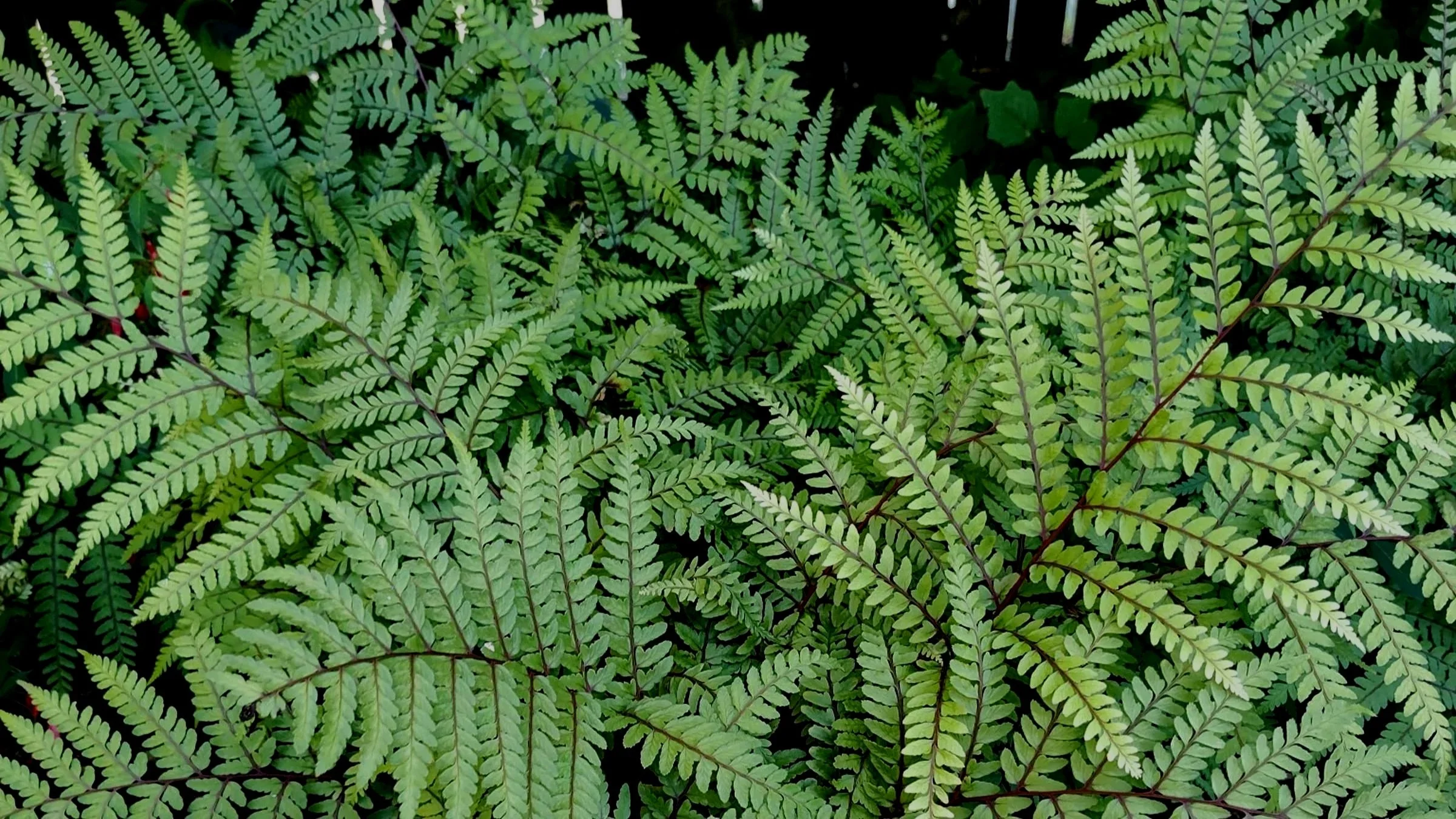As we head into the heat that is August, I think it is appropriate to talk about some shade plants this week, specifically ferns. Ferns, of many kinds, thrive in our local gardens, enjoying our maritime climate and mild winters. They will grow nicely in our typical woodland PNW gardens, just like we find them growing in local native habitats, enjoying our moist, well-drained acidic soils. A few can take more afternoon sun than others, but most prefer locations that receive morning sun/afternoon shade or dappled light under tree canopies. Ferns are all about adding texture, foliage, and style in the garden. Some make lovely singular specimens, but I would consider planting them in mass. Adding a swathe of three to five plants in a grouping makes a nice presentation indeed.
Ferns are super easy to grow, not fussy whatsoever and don’t need much care except an annual clean up each spring and adequate moisture in the drier summer months. I have a number of them in my own gardens and although I should not admit this, I cannot remember the last time I fed them. They were blessed with some organic transplant fertilizer at planting time and receive an annual spring mulching of compost, but that is about it. Each March I do clean mine up, both perennial and evergreen types, BEFORE the new fiddleheads emerge. Evergreen ones do not have to be cut back, but I have found cutting old fronds off allows the fresh growth to emerge uninhibited. If you are a touch OCD like me, they will look much tidier for the season by doing this as well.
Ferns represent some of the original plant life on planet earth, dating back to at least 350 million years ago. They have spread and evolved into almost every niche environment throughout the globe, numbering at an estimated 15,000 different species. I find it fascinating that man continues to still discover new species, particularly in tropical regions. I am also amazed that if you take a country like say Costa Rica, some 900 unique species thrive there alone, which is more diversity than grows in the entire North American continent, excluding Mexico! This is also why there are some really fun and fabulous ferns that can be grown as houseplants. Ferns do not flower but rather reproduce by spores. This has allowed them to evolve before flowering plants did, and even more importantly, before the relationship between insects/pollinators and plants developed.
Ferns are most certainly plants, but they do look a bit different than other types. They have fronds in lieu of leaves and thus in spring unfurl fiddleheads, one of my favorite sights in the garden. As a fern awakes each spring, pause and marvel at the wonders of nature’s rejuvenation! As I mentioned above, reproduction by spores remains their number one advantage, even in modern times. These plants essentially have both sexes on the same plant, eliminating the need for any pollination and resulting seed production. They have dispersed globally through the wind, tucking themselves into forests, rocky outcroppings, stream beds and everywhere in between over hundreds of millions of years. Follow the global winds and it is clear to see why this specie is found here and that one there, without a doubt.
Now that we have a bit of fern history and structure covered, let’s talk about some useful ferns for our local gardens. There are a bazillion possibilities to choose from for our climate zone, some remaining evergreen through our winters while others are great for growing as true perennials. Perennial types will die back with frost but new fiddleheads emerge each spring to make your specimen(s) bigger and better season after season.
Go with a native fern: There are some excellent native species to utilize locally. Western Sword Fern (Polystichum munitum) grows anywhere, including in more sun than some others. These are the classic evergreen choice and mature into clumps about 3 to 4-feet tall and wide over time. A little smaller and still evergreen is the Deer Fern (Blechnum spicant), growing to about 2-feet tall and 3-feet wide, with a lovely stiff structure and black stems. A great perennial option is the Western Maidenhair Fern (Adiantum aleuticum), with whimsical lacy foliage that is lovely to plant in masses and let naturalize. These thrive from Alaska all the way south to California! Two close relatives to these are Northern Maidenhair Fern (Adiantum pedatum) and Himalayan Maidenhair Fern (Adiantum venustum), both equally attractive with exquisitely textured fronds. All these species of Adiantum will stay under a foot and spread slowly, so be patient. As a bonus, the Himalayan version is typically evergreen in our area.
Go with a larger specimen fern: I hate to be the bearer of bad news, but we cannot grow the unbelievably cool tree-type ferns from Australia, Tasmania, or other tropical climates outdoors. However, there are a few larger growers that are plenty hardy to think about. European Ostrich Fern (Matteuccia struthiopteris) makes an impressive specimen, developing an actual trunk with time and sporting fronds that can be up to 4-feet long. These are perennial, but will reach specimen size of 6-feet tall and 8-feet wide with maturity. Another different one is Giant Chain Fern (Woodwardia fimbriata), which produces fronds over 6-feet long and attains a size of 8-feet tall and wide in the garden. These have intricate spore patterns under their fronds and a lovely touch of reddish color on its new growth each year. They are typically evergreen in our area and can be mulched to help protect them during the colder winters as well.
Go with some unique colors: We have plenty of green around here, as you are well aware, and although green in all its shades works nicely, a splash of color adds contrast, especially in the deep dark shade garden. Japanese Autumn Fern (Dryopteris erthyrosora) is semi-evergreen and forms clumps 2-feet tall and wide in the garden. While the older fronds are deep green, the new growth emerges a delicious coppery-red color that really pops and remains through fall. The variety ‘Prolifica’ of this specie may be even cooler with pinky red tones in the spring and fall, highly textured fronds and an extremely heavy spore production. ‘Jurassic Gold’ is a newer variety of Wood Fern (Dryopteris wallachina) that is one of my personal favs. New fronds emerge orangey-gold in color and then mature to a bright yellow-green. Clumps are usually evergreen in our region and reach about 2-feet tall and wide. ‘Pterodactyl’ Eared Lady Fern (Athyrium otophorum) is another Jurassic fern that I love in my yard - a perennial type with both dark green and lime green coloring and striking red stems. These mature to about 18-inces tall and wide in the landscape.
There are so many more good ones available worth mentioning. Spleenwort (Aslpenium trichomanes) is the cutest little fern ever, staying evergreen with nice texture and a small (less than a foot) stature. One cultivar of Lady Fern (Athyrium filix-femina) called ‘Victoriae’ is another one of my garden favs, with bright green color and unique crisscross pattern with crested tips on each frond. Painted Fern (Athyrium niponicum ‘Pictum’) and its associated cultivars (like ‘Ghost’, ‘Lady in Red’ or even ‘Godzilla’) all offer perennial habit, 18-inches in size and luminescent fronds touched with lavender, white, or red tones of varying intensity.
I invite you to investigate these useful ferns, and many others as well. A visit to the local garden center will help as a Certified Professional Horticulturist can steer you towards choosing the right ones for your garden and teach you how to cultivate them properly. Many should still be in stock over the summer and lots of fresh ones will be arriving for fall planting season as well. Keep in mind that many evergreen types are ideal for adding some pop to fall or winter container gardens in the shade. I am hoping that you go a little prehistoric in your garden and consider planting some fancy fronds full of texture and color in your own garden.
Remember, leaves (or for this week fronds) up, roots down…



